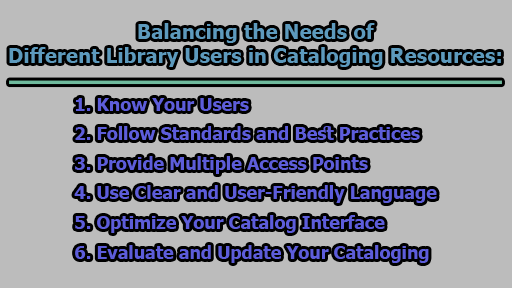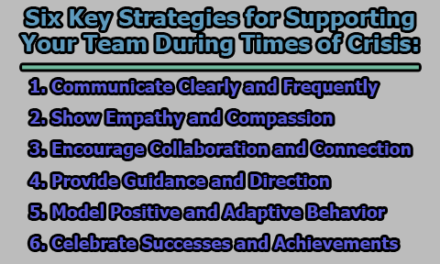Balancing the Needs of Different Library Users in Cataloging Resources:
Cataloging resources is an essential task in library services, ensuring that users can effectively locate and access the information they need. However, library users vary in their needs, preferences, and expectations regarding how resources are organized, described, and displayed. To provide a user-centric approach, librarians must balance the diverse requirements of their patrons. In this article, we will explore balancing the needs of different library users in cataloging resources.
1. Know Your Users: The first and most crucial step in balancing the needs of different library users is to understand who they are and what they require. Librarians can employ various methods to gather user feedback, such as surveys, interviews, focus groups, usability tests, analytics, and observation. Additionally, segmenting users into different categories based on age, education, discipline, language, or disability helps tailor cataloging to meet their unique needs and perspectives.
This knowledge enables librarians to make informed decisions when cataloging resources. For instance, they can prioritize specific access points, subject headings, or language choices based on user preferences, making the catalog more user-friendly.
2. Follow Standards and Best Practices: The second step in creating a balanced catalog is adhering to recognized standards and best practices in cataloging. Standards, such as MARC, RDA, AACR2, LCSH, DDC, LCC, and FRBR, provide rules and guidelines that ensure consistency, interoperability, and the quality of cataloging data. Best practices reflect current trends and expectations in the field.
By following these standards and best practices, librarians ensure that their cataloging is accurate, comprehensive, and compatible with other library systems and platforms. This consistency is vital for users who expect reliable and predictable cataloging methods.
3. Provide Multiple Access Points: To cater to a diverse user base, librarians should offer multiple access points in their catalogs. Access points are the elements of cataloging data that users can use to search, browse, and filter resources. These may include titles, authors, subjects, keywords, formats, genres, dates, and identifiers.
Providing multiple access points increases the chances of users finding what they need, regardless of how they formulate their queries or what criteria they use. Cross-references, synonyms, variants, and hierarchies can also be employed to link related access points and guide users to relevant resources, further enhancing the user experience.
4. Use Clear and User-Friendly Language: Language plays a crucial role in cataloging, as it serves as the primary medium of communication between librarians and users. Librarians should employ clear, user-friendly language that is simple, precise, and consistent. Jargon, abbreviations, acronyms, and technical terms that may confuse or alienate some users should be avoided unless they are widely recognized or explained.
Inclusivity and diversity should also be reflected in the language used in cataloging. Offensive, outdated, or biased terms should be avoided to ensure all users feel respected and represented in the catalog.
5. Optimize Your Catalog Interface: The catalog interface is the visual and interactive component of a library’s catalog system. To cater to the diverse needs and preferences of users, librarians should design the interface to be attractive, intuitive, and responsive. This can be achieved through a careful selection of colors, fonts, icons, images, and layouts that are both visually appealing and easy to read.
In addition to aesthetics, librarians should incorporate features and functions that enhance the user experience. This includes offering advanced search options, filters, facets, sorting, display modes, navigation, help, and feedback options. An optimized catalog interface not only makes cataloging resources more accessible but also encourages users to explore the library’s offerings more effectively.
6. Evaluate and Update Your Cataloging: Cataloging is not a one-time process but an ongoing and dynamic one. To ensure that cataloging remains relevant, reliable, and responsive to the needs of different library users, librarians must evaluate and update their cataloging regularly. This involves monitoring and measuring performance and impact using statistics, indicators, benchmarks, and feedback.
Furthermore, cataloging should be reviewed and revised to reflect changes and developments in the library’s collection, user needs, standards, and the evolving environment. By keeping cataloging up-to-date, librarians can adapt to changing user expectations and continue providing an exceptional cataloging experience.
In conclusion, balancing the needs of different library users when cataloging resources is a multifaceted endeavor that requires a deep understanding of user preferences, adherence to standards, and the implementation of user-friendly language and interfaces. By following these six steps – knowing your users, adhering to standards, providing multiple access points, using clear language, optimizing the catalog interface, and regularly evaluating and updating cataloging – librarians can create a catalog that caters to the diverse needs of their user base, ensuring a more inclusive and accessible library experience for all.

Library Lecturer at Nurul Amin Degree College










